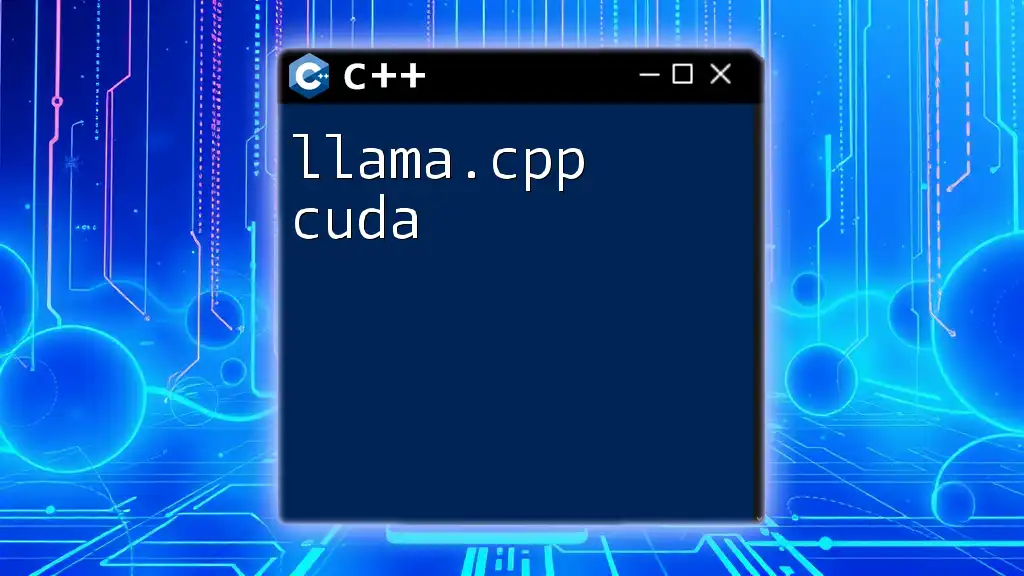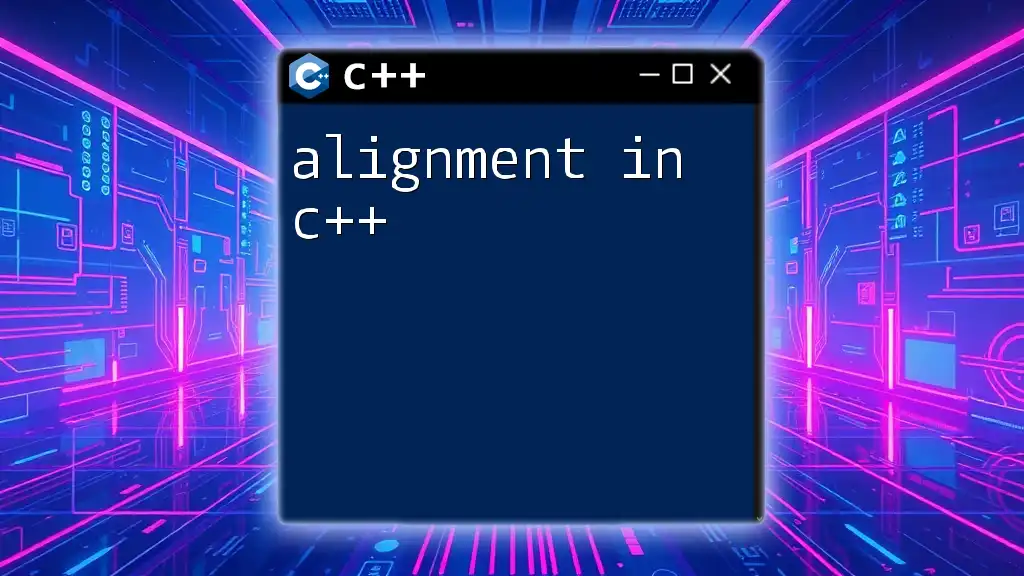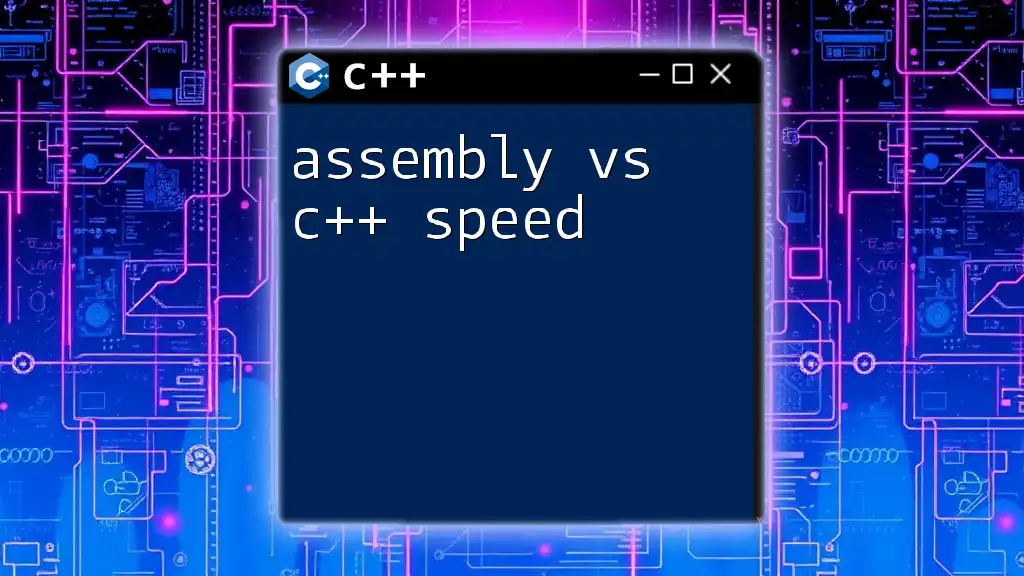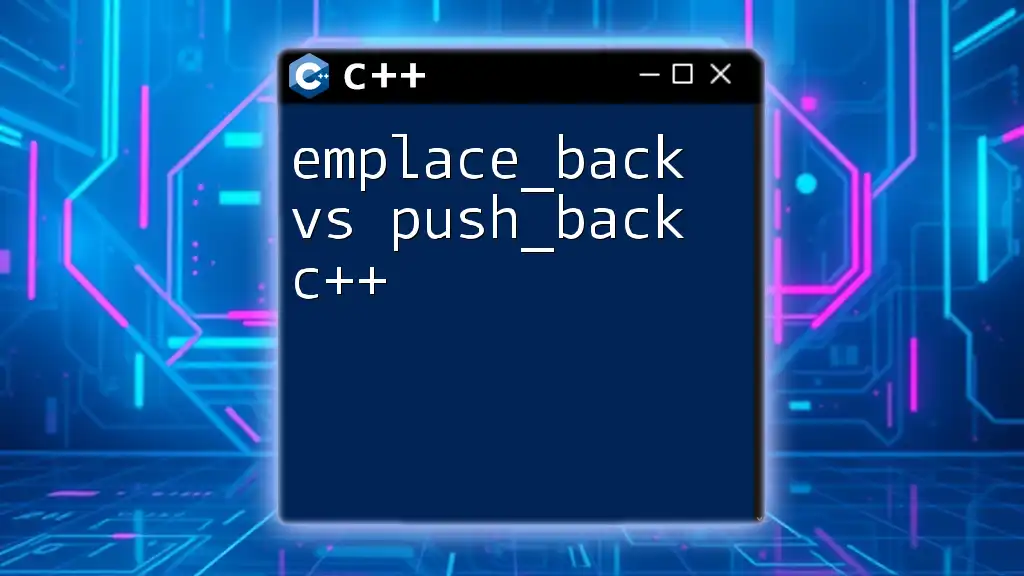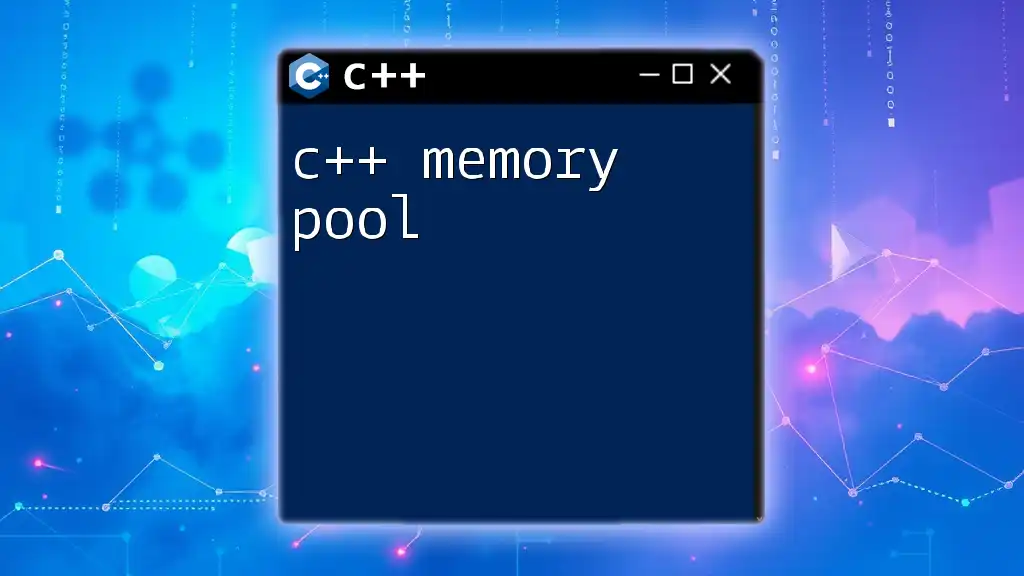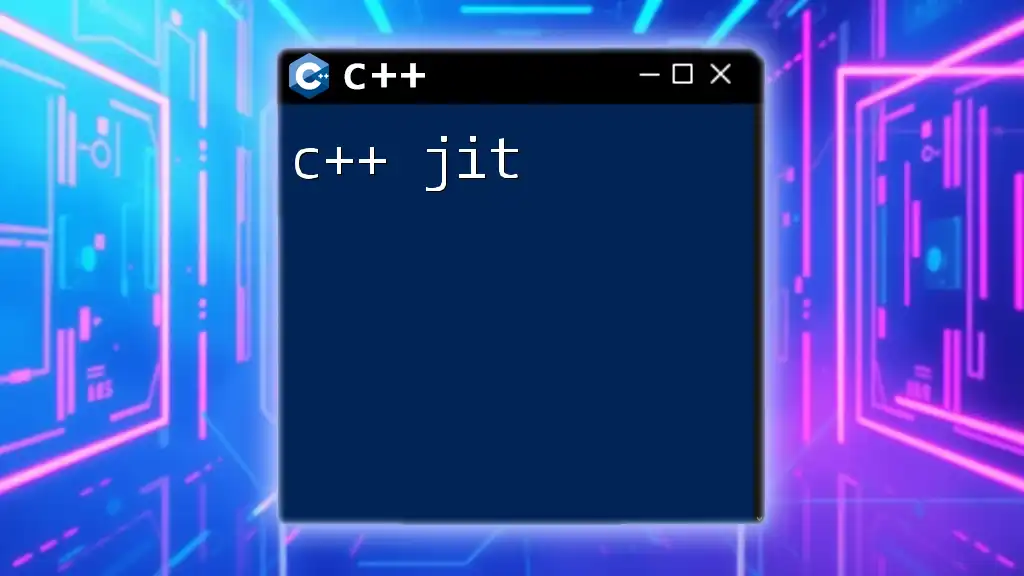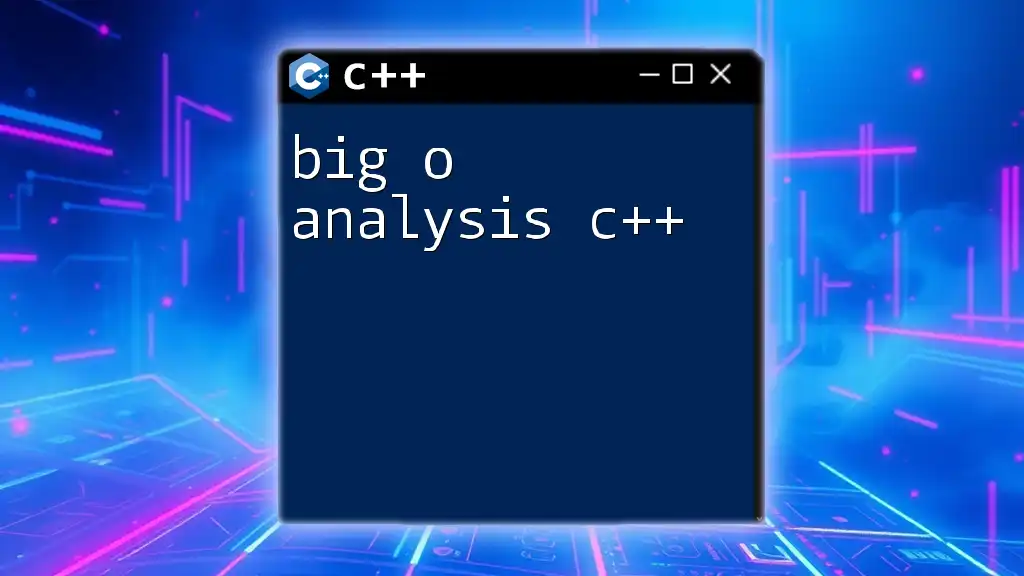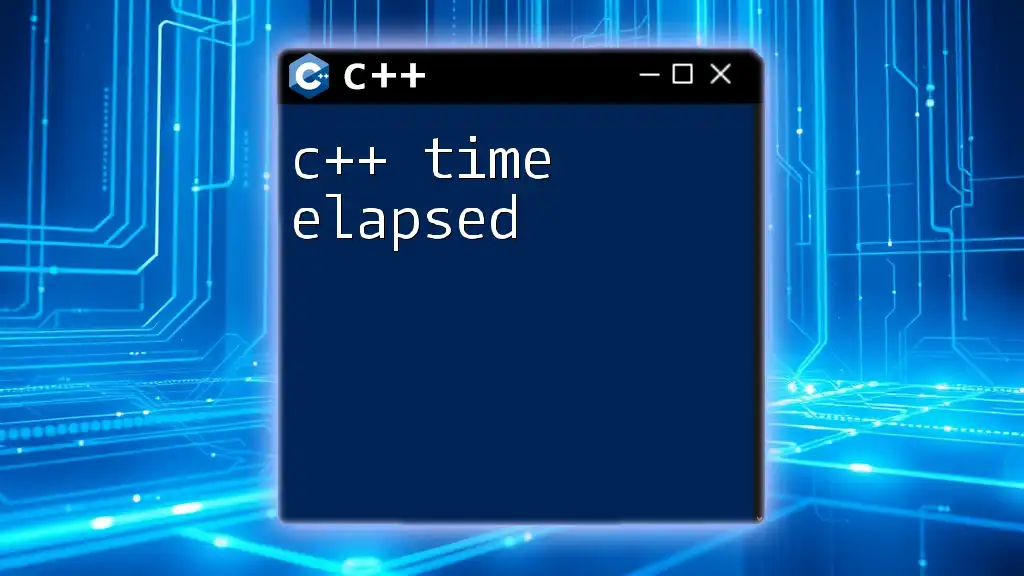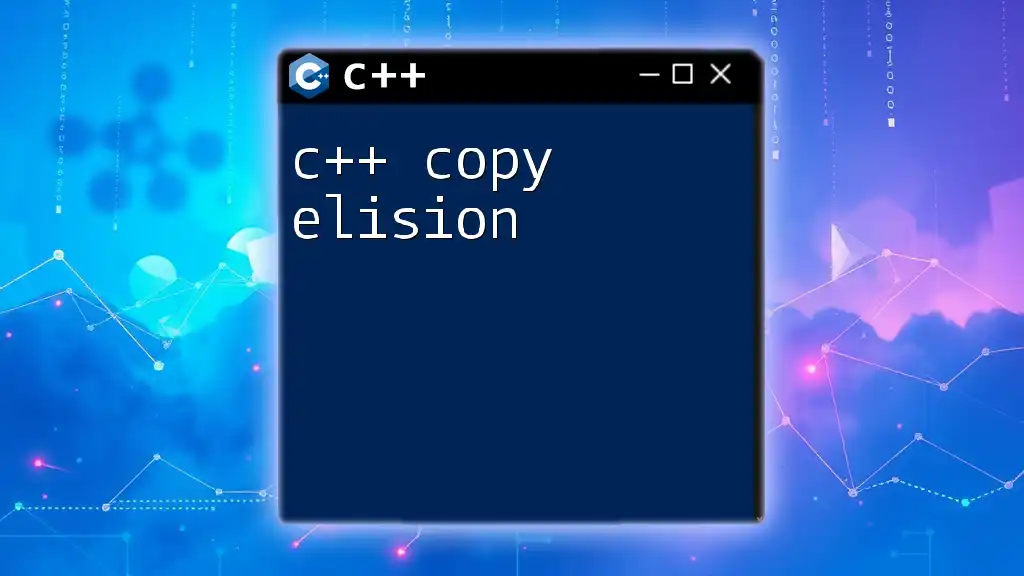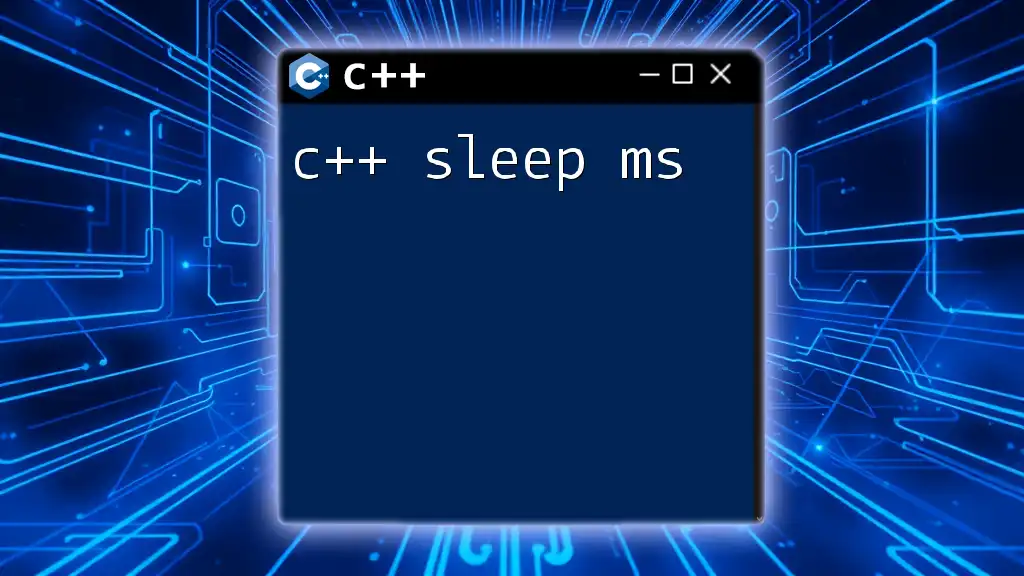Introduction to C++ Performance
Performance is a critical factor in software engineering, especially with C++, a language renowned for its execution speed and resource efficiency. In an era that demands efficient computing, understanding the nuances of C++ performance can give developers the edge they need to create high-performing applications. This guide serves as a comprehensive resource for improving your knowledge about C++ performance metrics, best practices, and various techniques.
To get started on your journey towards optimizing C++ performance, refer to our foundational resource on C++ Performance.
C++ Classic Performance
C++ has undergone numerous iterations since its inception in the early 1980s, each bringing improvements to the language and its performance. Its classic version laid the groundwork for many performance principles still relevant today.
Understanding C++ Classic Performance
C++ Classic refers to the characteristics and features of C++ before the introduction of modern updates. In the early days, C++ was designed for system programming and software that required efficient memory and processing capabilities.
-
Historical Context: C++ was built upon the foundations of C, which focused on efficiency. Thus, C++ retained this quality while adding object-oriented and generic programming features. By understanding these basics, developers can appreciate the inherent power of C++ for creating performant applications.
-
Evolution of C++ Performance: The evolution continued with standards such as C++11, C++14, C++17, and C++20. Each version introduced optimizations and syntactical improvements that refined how C++ code could interact with hardware and take advantage of newer architectures.
Performance Features of C++ Classic
C++ Classic includes various features that can greatly enhance performance in applications:
- Inlining Functions: By marking functions as
inline, you suggest to the compiler that it should insert function code directly into the calling code, reducing the overhead of the function call. This can lead to speed improvements when functions are small and called frequently. Here’s an example:
inline int add(int a, int b) {
return a + b;
}
- Using Pointers: C++ allows direct memory access via pointers, which can enhance performance by enabling recursion and dynamic memory allocation. The following example illustrates how to utilize pointers effectively:
int main() {
int a = 10;
int* pA = &a; // Pointer to a
std::cout << "Value of a: " << *pA << std::endl; // Dereferencing
}
By harnessing these features, developers can write more efficient code that accelerates execution times.
Analyzing C++ Versions
The differences in performance between various C++ versions can be intriguing, especially when evaluating legacy codebases versus modern implementations.
What is C++ 1.13?
C++ 1.13 is one of the earlier versions of the C++ language standard. Although it is not commonly used today, understanding its foundations can provide insight into the evolution of C++ and how past optimizations have shaped current practices in software development.
Performance Evaluation of C++ 1.13
-
Advantages: This version laid the groundwork for features we now take for granted, such as strong typing. C++ 1.13 improved readability and maintainability of the code, essential factors for performance in larger applications.
-
Limitations: However, as advancements were made, it lacked several optimizations present in modern standards, such as move semantics and the rich standard library, which help improve runtime performance. Developers often face challenges when using outdated standards, such as performance issues in memory management and lack of support for modern multi-threading constructs.
For a deeper understanding of whether it is effective to still use this version, check our analysis on Is 1.13 C++ Good?.
Move Semantics in C++
Move semantics have changed the landscape of performance optimization in modern C++. This feature is particularly useful in applications that demand high efficiency, leading to improved utilization of system resources.
Understanding Move Semantics
At its core, move semantics allows developers to transfer resources from one object to another without incurring the overhead of copying. Traditionally, copying an object duplicating all the underlying resource management, making it both time-consuming and memory-intensive.
- Rvalue References: Introduced in C++11, rvalue references allow the programmer to distinguish between temporary (rvalues) and persistent (lvalues) objects. The
&&syntax denotes rvalue references.
Here’s an example of how to use rvalue references effectively:
class Vector {
public:
int* data;
size_t size;
Vector(size_t n) : size(n), data(new int[n]) {}
// Move constructor
Vector(Vector&& other) noexcept : data(other.data), size(other.size) {
other.data = nullptr; // Prevent the destructor from deleting the data.
}
~Vector() { delete[] data; }
};
Performance Benefits of Move Semantics
By allowing the transfer of ownership of resources, move semantics optimizes performance, especially in scenarios involving temporary objects. For instance, when returning large objects from functions, move semantics can eliminate the need for a costly deep copy, drastically reducing execution time.
To dive deeper into how move semantics can improve your coding practices, check out C++ Move Semantics.
Performance Measurement with C++ Timer
To optimize performance effectively, it's crucial to measure it accurately. C++ provides various mechanisms to track execution time.
Introduction to C++ Timer Functions
C++ offers robust libraries, such as <chrono>, which are built into the standard library for time measurement.
Here’s an example of how to create a simple timer in C++:
#include <iostream>
#include <chrono>
void sampleFunction() {
// Simulate some processing
for (volatile int i = 0; i < 100000; ++i);
}
int main() {
auto start = std::chrono::high_resolution_clock::now();
sampleFunction();
auto end = std::chrono::high_resolution_clock::now();
std::chrono::duration<double> duration = end - start;
std::cout << "Duration: " << duration.count() << " seconds." << std::endl;
return 0;
}
Use-Cases for C++ Timer
-
Benchmarking Algorithms: By timing different algorithms, developers can evaluate which performs better under specific conditions, leading to informed decisions about the optimal approach to problem-solving.
-
Profiling Applications: Timers help identify bottlenecks within the application code, enabling developers to focus their optimization efforts precisely where it will make the most impact.
For more elaborate information about accurate timing methods and their applications in C++, visit C++ Timer.
Efficient Memory Handling with memcpy
Efficient memory management is critical for achieving high performance in C++. One of the key functions helpful in this respect is memcpy.
Overview of memcpy in C++
The memcpy function allows developers to copy data from one memory location to another efficiently. This operation is particularly effective when transferring large blocks of memory.
#include <cstring> // Include necessary header for memcpy
int main() {
int src[10] = {0, 1, 2, 3, 4, 5, 6, 7, 8, 9};
int dest[10];
std::memcpy(dest, src, sizeof(src)); // Copying data from src to dest
return 0;
}
Performance Analysis of memcpy
-
Fast Execution: Since
memcpyis often optimized at the assembly level by the compiler, it can outperform manually written loops for copying memory. It leverages capabilities of the underlying architecture to execute the transfer as quickly as possible. -
When to Use memcpy Over Alternatives: Use
memcpyfor bulk data transfers where type safety is not a concern. However, caution is necessary in scenarios involving class instances or pointers, as this can lead to shallow copies and potential memory issues.
To see further details on when to use memcpy, refer to memcpy in C++.
Understanding Atomic Types in C++
Atomic types are essential in multi-threaded applications where data integrity must be maintained without resorting to complex locking mechanisms.
Definition and Use-Cases of C++ Atomic Int
The std::atomic class in C++ ensures that read and write operations on the atomic variable are executed as single, unbroken actions. This means they're safe to use across multiple threads without the risk of data corruption.
Here’s a simple usage of std::atomic:
#include <atomic>
#include <iostream>
std::atomic<int> atomicCounter(0); // Initialize an atomic counter
void increment() {
atomicCounter++; // Increment the atomic counter safely
}
int main() {
increment();
std::cout << "Atomic counter value: " << atomicCounter << std::endl;
return 0;
}
Performance Implications of Using Atomic Types
Using atomic types not only ensures thread safety but also introduces minimal overhead compared to mutex-based mechanisms. This allows developed systems to achieve higher performance by avoiding the complexities involved in thread locking.
To learn more about how to leverage atomic types in your applications, see C++ Atomic Int.
Comparison of Java vs C++
Analyzing the performance differences between languages is important in selecting the most suitable one for specific projects.
Performance Metrics Comparison
-
Execution Speed: C++ holds an advantage in execution speed due to its compiled nature. With C++, code is translated into machine code before execution, eliminating the overhead associated with runtime interpretation, as seen in Java, which runs on the Java Virtual Machine (JVM).
-
Memory Management: C++ gives programmers fine-grained control over memory management, allowing manual allocation and deallocation of resources. In contrast, Java abstracts this with its garbage collection mechanism, which may introduce delays and affect performance in memory-intensive applications.
When to Choose C++ Over Java for Performance
C++ shines in situations that require real-time processing or applications that are resource-intensive, such as game engines, high-performance simulations, or systems programming. Developers should carefully evaluate the requirements of their specific tasks when choosing between these languages. For targeted performance analysis, explore our detailed comparison in Java vs C++.
Utilizing Emplace in C++
The emplace method is a relatively recent addition to C++ that enables in-place construction of elements in data structures, allowing for optimized handling of resources.
What is Emplace in C++?
emplace constructs an object directly in the allocated space of a container such as std::vector or std::map. This method reduces the overhead of additional copying, which can lead to performance gains.
Here’s an example demonstrating the use of emplace:
#include <vector>
struct Point {
int x, y;
};
std::vector<Point> points;
points.emplace_back(1, 2); // Constructs Point(1, 2) directly in the vector.
Performance Advantages of Using Emplace
This operation is beneficial as it eliminates the need for a temporary object which is usually created when using push_back(). This leads to less memory usage and faster execution, particularly in heavy-load scenarios where many objects are being added to a container. For a thorough examination of when and how to use emplace, see Emplace in C++.
GPU Programming with GPU.CPP
With an increasing demand for high-performance applications, the importance of GPU (Graphics Processing Unit) programming has surged.
Understanding GPU Programming
GPU.CPP is an illustration of a bridge that allows developers to harness the power of GPUs for accelerating computations that are highly parallelizable. Unlike CPUs, GPUs consist of hundreds of cores designed to handle multiple operations concurrently.
Performance Gains with GPU.CPP
By performing computations on the GPU, developers can experience significant performance improvements in data-intensive applications like graphics rendering, machine learning, and scientific simulations. Using GPU.CPP, you can write code that seamlessly utilizes GPU resources without dealing with the complexities typically associated with GPU programming. To learn more about these capabilities, refer to GPU.CPP.
Accelerated C++
Accelerated C++ is a book that focuses on practical implementations aimed at enhancing C++ programming skills, primarily concerning performance.
Introduction to Accelerated C++
Written by Andrew Koenig and Barbara E. Moo, this book emphasizes practical approaches to improving coding skills, with a focus on efficiency and clarity.
Key Features and Performance Aspects
- Practical Examples: The book includes numerous real-world scenarios that show how to write efficient C++ code, thereby enhancing understanding and application of performance best practices.
Developers eager to refine their skills can benefit immensely from the insights shared in this landmark resource. Explore more at Accelerated C++.
C++ Performance Tools and Resources Online
To achieve the best performance in your C++ applications, numerous tools are available for benchmarking, profiling, and monitoring performance.
Overview of C++ Performance Tools Available Online
There are a variety of tools tailored for developers looking to optimize their C++ applications. Tools such as Valgrind for memory analysis, Google Benchmark for micro-benchmarks, and Gprof for profiling CPU performance can provide actionable insights.
How to Benchmark C++ Applications
Understanding how to benchmark effectively is key to improving performance. With tools like Google Benchmark, you can create micro-benchmarks that provide precise insights about execution times of functions and algorithms.
For a deeper understanding of C++ performance tools available online, complete with recommendations and implementation guides, visit C++ Performance Online.
Building Low Latency Applications with C++
In industries where responsiveness is paramount, low latency is crucial for ensuring that applications react quickly to user input or external events.
Understanding Low Latency Requirements
Low latency applications are designed to minimize the delay between an input event and its corresponding output response. This is a significant factor in sectors such as finance, telecommunications, and gaming, where even a small delay can result in substantial losses.
Techniques for Building Low Latency Applications
-
Optimized Algorithms: Select algorithms that are efficient and have favorable time complexity to improve response times. For example, choosing a sorting algorithm based on the nature of the data can have a significant impact on performance.
-
Efficient Networking: Employ robust communication protocols that minimize delays, such as using UDP for fast, connectionless communication instead of TCP, which is reliable but inherently introduces latency.
Link to Additional Resource
To enhance your knowledge further, check out Building Low Latency Applications with C++ for additional strategies and best practices.
Garbage Collection in C++
Garbage collection (GC) in C++ can be paradoxical since C++ emphasizes manual memory management, contrasting with languages like Java that rely heavily on automatic garbage collection. However, an understanding of memory management principles in C++ can greatly affect performance.
Understanding Garbage Collection Basics
Garbage collection in programming refers to the automatic recycling of memory that is no longer in use. In contrast, C++ allows developers to manage memory manually through new and delete commands.
Manual vs Automatic Memory Management in C++
- Manual Memory Management: C++ allows developers to allocate memory explicitly using
newand release it usingdelete. This approach provides flexibility, but it demands care to avoid memory leaks or dangling pointers:
int *array = new int[10]; // Allocate memory
delete[] array; // Deallocate memory
- Automatic Memory Management: While C++ does not have built-in garbage collection, there are libraries available, such as the Boost Garbage Collector, which can assist in managing memory automatically in specific scenarios.
Performance Considerations for Garbage Collection
While manual memory management in C++ provides control, it comes with responsibility. Poorly managed memory can lead to leaks and degraded performance. Knowing when to apply manual management versus automated techniques can greatly influence application performance. For a deeper dive into this topic, consult Garbage Collection in C++.
Multithreading in C++
Multithreading is an essential technique for maximizing the usage of multi-core processors in modern hardware, especially in applications requiring high responsiveness or throughput.
Introduction to Multithreading
- Differentiation Between Threads and Processes: Threads share a common memory space, which allows them to communicate easily and efficiently. In contrast, processes have distinct memory spaces and require more overhead for inter-process communication.
Performance Advantages of Multithreading in C++
By utilizing multithreading, applications can handle multiple tasks concurrently, reducing execution time and improving responsiveness. For example, a web server can handle multiple client requests in parallel, leading to better performance during high-traffic periods.
Key Libraries and Frameworks for Multithreading
C++ offers robust multithreading support through libraries such as the C++11 standard threading library, which provides constructs like std::thread, std::mutex, and std::condition_variable, streamlining the development of multithreaded applications.
Here's a brief usage of std::thread:
#include <iostream>
#include <thread>
void task() {
std::cout << "Running task in thread" << std::endl;
}
int main() {
std::thread t(task);
t.join(); // Wait for the thread to finish
return 0;
}
Multithreading Best Practices
-
Potential Pitfalls: Be aware of issues such as race conditions, deadlocks, and data inconsistencies. Proper synchronization is necessary to avoid these hazards.
-
Testing for Thread Safety: Ensuring that shared resources accessed across threads are properly synchronized is critical for maintaining data integrity. Techniques such as locks and condition variables can help manage concurrency effectively.
To learn more about the advantages and best practices of multithreading, visit Multithreading in C++ and explore advanced threading concepts at Multi Thread in C++.
Time-Sensitive Application Development
In applications where timing is critical, having control over execution timing can be paramount for maintaining performance.
Introduction to C++ Usleep
The usleep function in C++ allows developers to pause execution for a specified period, thus controlling the timing of code execution.
Here’s a simple implementation:
#include <unistd.h> // Necessary for usleep
int main() {
usleep(1000000); // Sleep for 1 second
return 0;
}
Using usleep, developers can create time gaps between tasks or control the timing of polling loops.
Performance Impacts of Usleep and Alternatives
While usleep can effectively manage delays, relying excessively on it can introduce unpredictable latency in applications. It’s important to consider alternatives, such as event-driven programming models or scheduling libraries, which may better suit high-performance needs. For a closer look at its usage, refer to C++ Usleep.
Advanced Concurrency in C++
Concurrency in C++ is an expansive topic that has become increasingly relevant with the growing complexity of software systems.
Overview of Concurrency in C++
Modern C++ provides various constructs that facilitate concurrent programming. The C++11 standard introduced features that make it easier to work with threads and synchronization primitives.
Key Concepts Highlighted in "C++ Concurrency in Action"
This book, authored by Anthony Williams, serves as a detailed guide to the principles of concurrency in C++, including real-world scenarios and practical examples. It emphasizes understanding the underlying models and best practices for implementing concurrency effectively.
Practical Samples and Worked Examples
Through hands-on coding examples, the book illustrates how to tackle common concurrency challenges, offering insights that can greatly improve your application's performance and reliability. To enhance your knowledge further, refer to C++ Concurrency in Action.
Conclusion
C++ performance is a multifaceted topic that requires a blend of knowledge and practical experience. By leveraging the discussed techniques and understanding the various surrounding topics, developers can create highly efficient applications. From mastering memory management to understanding advanced features like concurrency and atomic types, each area plays a crucial role in achieving optimal performance.
Dive deeper into the specific sections linked thoughtfully throughout this guide to sharpen your expertise in C++ performance, and be sure to revisit our foundational concepts at C++ Performance.






